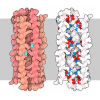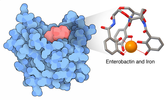+ Open data
Open data
- Basic information
Basic information
| Entry | Database: PDB / ID: 2fcg | ||||||
|---|---|---|---|---|---|---|---|
| Title | Solution structure of the C-terminal fragment of human LL-37 | ||||||
 Components Components | Antibacterial protein FALL-39, core peptide Antibiotic Antibiotic | ||||||
 Keywords Keywords |  ANTIMICROBIAL PROTEIN / ANTIMICROBIAL PROTEIN /  LL-37 / host defense peptide / LL-37 / host defense peptide /  antimicrobial peptide antimicrobial peptide | ||||||
| Function / homology |  Function and homology information Function and homology information cytolysis / killing by host of symbiont cells / cytolysis / killing by host of symbiont cells /  neutrophil activation / neutrophil activation /  specific granule / cellular response to peptidoglycan / cellular response to interleukin-6 / specific granule / cellular response to peptidoglycan / cellular response to interleukin-6 /  Antimicrobial peptides / cellular response to interleukin-1 / Antimicrobial peptides / cellular response to interleukin-1 /  innate immune response in mucosa / cell projection ... innate immune response in mucosa / cell projection ... cytolysis / killing by host of symbiont cells / cytolysis / killing by host of symbiont cells /  neutrophil activation / neutrophil activation /  specific granule / cellular response to peptidoglycan / cellular response to interleukin-6 / specific granule / cellular response to peptidoglycan / cellular response to interleukin-6 /  Antimicrobial peptides / cellular response to interleukin-1 / Antimicrobial peptides / cellular response to interleukin-1 /  innate immune response in mucosa / cell projection / innate immune response in mucosa / cell projection /  lipopolysaccharide binding / specific granule lumen / positive regulation of angiogenesis / antimicrobial humoral immune response mediated by antimicrobial peptide / tertiary granule lumen / cellular response to tumor necrosis factor / antibacterial humoral response / cellular response to lipopolysaccharide / defense response to Gram-negative bacterium / amyloid fibril formation / defense response to Gram-positive bacterium / defense response to bacterium / positive regulation of protein phosphorylation / lipopolysaccharide binding / specific granule lumen / positive regulation of angiogenesis / antimicrobial humoral immune response mediated by antimicrobial peptide / tertiary granule lumen / cellular response to tumor necrosis factor / antibacterial humoral response / cellular response to lipopolysaccharide / defense response to Gram-negative bacterium / amyloid fibril formation / defense response to Gram-positive bacterium / defense response to bacterium / positive regulation of protein phosphorylation /  innate immune response / positive regulation of cell population proliferation / Neutrophil degranulation / innate immune response / positive regulation of cell population proliferation / Neutrophil degranulation /  extracellular space / extracellular exosome / extracellular region extracellular space / extracellular exosome / extracellular regionSimilarity search - Function | ||||||
| Method |  SOLUTION NMR / SOLUTION NMR /  simulated annealing simulated annealing | ||||||
 Authors Authors | Wang, G. / Li, X. | ||||||
 Citation Citation |  Journal: J.Am.Chem.Soc. / Year: 2006 Journal: J.Am.Chem.Soc. / Year: 2006Title: Solution Structures of Human LL-37 Fragments and NMR-Based Identification of a Minimal Membrane-Targeting Antimicrobial and Anticancer Region. Authors: Li, X. / Li, Y. / Han, H. / Miller, D.W. / Wang, G. | ||||||
| History |
|
- Structure visualization
Structure visualization
| Structure viewer | Molecule:  Molmil Molmil Jmol/JSmol Jmol/JSmol |
|---|
- Downloads & links
Downloads & links
- Download
Download
| PDBx/mmCIF format |  2fcg.cif.gz 2fcg.cif.gz | 175.3 KB | Display |  PDBx/mmCIF format PDBx/mmCIF format |
|---|---|---|---|---|
| PDB format |  pdb2fcg.ent.gz pdb2fcg.ent.gz | 151.8 KB | Display |  PDB format PDB format |
| PDBx/mmJSON format |  2fcg.json.gz 2fcg.json.gz | Tree view |  PDBx/mmJSON format PDBx/mmJSON format | |
| Others |  Other downloads Other downloads |
-Validation report
| Arichive directory |  https://data.pdbj.org/pub/pdb/validation_reports/fc/2fcg https://data.pdbj.org/pub/pdb/validation_reports/fc/2fcg ftp://data.pdbj.org/pub/pdb/validation_reports/fc/2fcg ftp://data.pdbj.org/pub/pdb/validation_reports/fc/2fcg | HTTPS FTP |
|---|
-Related structure data
- Links
Links
- Assembly
Assembly
| Deposited unit | 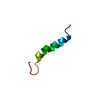
| |||||||||
|---|---|---|---|---|---|---|---|---|---|---|
| 1 |
| |||||||||
| NMR ensembles |
|
- Components
Components
| #1: Protein/peptide |  Antibiotic / FALL-39 peptide antibiotic / Cationic antimicrobial protein CAP-18 / hCAP-18 Antibiotic / FALL-39 peptide antibiotic / Cationic antimicrobial protein CAP-18 / hCAP-18Mass: 3050.623 Da / Num. of mol.: 1 / Fragment: residues 146-170 / Source method: obtained synthetically Details: sequence corresponds to residues 146-170 of Human FALL-39 References: UniProt: P49913 |
|---|
-Experimental details
-Experiment
| Experiment | Method:  SOLUTION NMR SOLUTION NMR | ||||||||||||||||||||||||
|---|---|---|---|---|---|---|---|---|---|---|---|---|---|---|---|---|---|---|---|---|---|---|---|---|---|
| NMR experiment |
| ||||||||||||||||||||||||
| NMR details | Text: A set of NMR data was also collected at 310 K. |
- Sample preparation
Sample preparation
| Details | Contents: 2 mM peptide and 80 mM SDS / Solvent system: 10% D2O/90%H2O |
|---|---|
| Sample conditions | Ionic strength: 80 / pH: 5.4 / Pressure: 1 atm / Temperature: 298 K |
-NMR measurement
| NMR spectrometer | Type: Varian INOVA / Manufacturer: Varian / Model : INOVA / Field strength: 600 MHz : INOVA / Field strength: 600 MHz |
|---|
- Processing
Processing
| NMR software |
| ||||||||||||||||||||
|---|---|---|---|---|---|---|---|---|---|---|---|---|---|---|---|---|---|---|---|---|---|
| Refinement | Method:  simulated annealing / Software ordinal: 1 simulated annealing / Software ordinal: 1 | ||||||||||||||||||||
| NMR representative | Selection criteria: lowest energy | ||||||||||||||||||||
| NMR ensemble | Conformer selection criteria: structures with the lowest energy Conformers calculated total number: 100 / Conformers submitted total number: 20 |
 Movie
Movie Controller
Controller







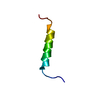
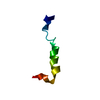


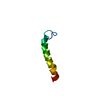
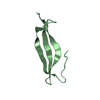
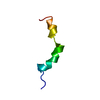

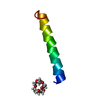

 PDBj
PDBj